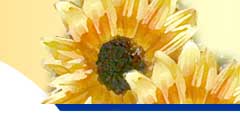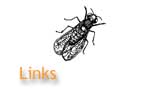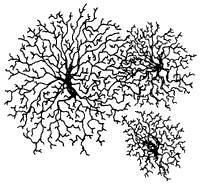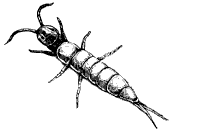



Microbes are a wide variety of organisms and are naturally present in all organic matter.
Primary Consumers are organisms that eat organic residues.

Bacteria are the smallest living organisms and the most numerous in compost; they make up 80 to 90% of the billions of microorganisms typically found in a gram of compost. Bacteria are responsible for most of the decomposition and heat associated with composting. Bacteria are single-celled and structured as either rod-shaped bacilli, sphere-shaped cocci or spiral-shaped spirilla. Bacteria don't have to be added to the compost. They are present virtually everywhere, and enter the pile on every single bit of organic matter. Many types of bacteria participate in the composting process, thriving at different temperatures and on different materials.
Psychrophiles are aerobic bacteria that thrive in low temperatures of approximately 55 degrees Fahrenheit and will slowly decompose compost even at 0 degrees Fahrenheit.



![]()

.
Mesophiles are most active at the
70-90 degrees Fahrenheit temperatures. These aerobic bacteria do most
of the work.
Thermophiles quickly raise the temperature in the pile to levels that kill most weed seeds.
Actinomycetes resembles fungi but actually are filamentous bacteria. Like other bacteria, they lack nuclei, but they grow multicellular filaments like fungi. In composting they play an important role in degrading complex organics such as cellulose, lignin, chitin, and proteins. Their enzymes enable them to chemically breakdown tough woody materials. Actinomycetes form long, thread-like branched filaments that look like gray spider webs stretching throughout compost, and give the pile a pleasing earthy smell.
Fungi includes molds and yeasts, which lack chlorophyll, the green pigment that allows most plants to convert sunlight into carbohydrate. Most fungi are classified as saprophytes because they obtain nutrients from dead plant matter. In compost, fungi are important because they break down tough debris, enabling bacteria to continue the decomposition process once most of the cellulose has been exhausted. Fungi species are numerous during both mesophilic and thermophilic phases of composting.
Sowbugs are fat bodied crustaceans with delicate plate-like gills along the lower surface of their abdomens, which must be kept moist. They feed on woody materials and durable leaf tissues.
Earthworms play an important role in breaking down organic materials and stabilizing finished compost. They are constantly tunneling and feeding on dead plants and decaying insects during the daylight hours. Their tunneling aerates the compost and enables water, nutrients and oxygen to filter down. They coat organic materials with a mucus-like film that binds small particles together and protect nutrients from leaching.
Millipedes are slower and more cylindrical than centipedes and have two pairs of appendages on each body segment. They feed mainly on decaying plant tissue but will eat insect carcasses and excrement.
Secondary Consumers are organisms that eat primary consumers.
Nematodes, or roundworms, are the most abundant invertebrates in the soil. Though there are pest forms of nematodes, most are beneficial. They prey on bacteria, protozoa, fungal spores and each other.
Mites are the second most common invertebrates found in compost. Some can be seen with the naked eye and others are microscopic. They have eight leg-like jointed appendages. Some feed on yeasts in fermenting materials, while others feed on nematodes, eggs, insect larvae and other mites.
Protozoa are one-celled microscopic animals. They are found in water droplets in compost but play a relatively minor role in decomposition. Protozoa obtain their food from organic matter in the same way as bacteria do but also act as secondary consumers ingesting bacteria and fungi.
Springtails are extremely numerous in compost. They are very small wingless insects and can be distinguished by their ability to jump when disturbed. They feed principally on fungi, although they also eat nematodes and small bits of organic detritus.
Tertiary Consumers are organisms that eat secondary consumers.
Centipedes are fast moving predators found mostly in the top few inches of the compost heap. They have formidable claws behind their head, which possess poison glands that paralyze small red worms, insect larvae, newly hatched earthworms, and spiders.
Definitions taken from Cornell University's composting website and Florida's On-line Composting Center.
top
Home
| Overview | About
| Benefits | Glossary
Links | Microbes |
Setup | Inside | Activities